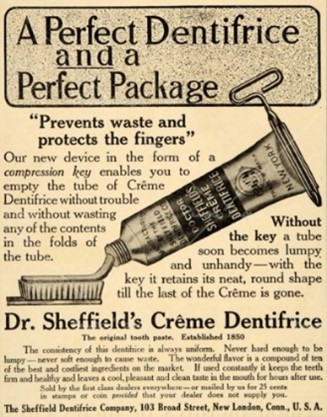Toothpaste, dental cream, tooth gel or oral paste – no matter what we call it, it has been part of our daily lives for as long as we can remember.
However, what is so simple today, consisting of just squeezing a tube from which we get the exact amount we need to keep our teeth healthy and clean, centuries ago had its long history and variants.
How did ancient civilisations clean their teeth and what did they use to do so?
The evolution of toothpaste
To talk about the origins of toothpaste we have to go back 4.000 years. Oral health has always been a concern for civilisations.
Centuries ago, they were already using their knowledge to make natural toothpastes with ingredients such as charcoal, coral powder and barley powder.
The evolution of toothpaste to the innovative toothpaste formulations we enjoy today has gone through many phases.
Oral health in Egyptian times
The first allusion to oral hygiene in ancient civilisations is found in an Egyptian manuscript from the 4th century BC, which related oral health to social status.
This allusion refers to a kind of highly abrasive toothpaste known as “clister”. To make it, the Egyptians mixed salt, powdered pumice, pepper, oxen nails, water, eggshell and myrrh. It was characterised by a strong taste and smell, so mint leaves and flowers were sometimes included to disguise the intensity of the product and prevent bad breath.
The first documented dentist was also Egyptian, a further sign of the importance they attached to oral health and appearance.
The Egyptians’ interest in oral hygiene and the appearance of their teeth was so strong that they had a few other techniques for making toothpaste: several records mention a compound of herbs and brick dust, with the herbs providing antiseptic properties and the brick dust providing abrasive and cleansing properties. To use this toothpaste, they moistened a soft-bristled brush with water and dipped it in the paste to brush their teeth in a circular motion.
Greek and Roman cultures and oral care
In ancient Greece and Rome, oral hygiene was as essential as it was for the Egyptians.
To care for their teeth, they used a mixture of honey, salt and ash as toothpaste. Honey was attributed with antiseptic properties, while salt and ashes helped to remove surface stains and plaque from the teeth.
To use this mixture, both Greeks and Romans first moistened a soft-bristled brush with water, and then applied it in a circular motion to their teeth.
In addition to this mixture, and according to writings such as Corpus Hippocraticum, by the Greek botanist Pedanius Dioscorides, or texts by the poet Martial, the Romans had another toothpaste recipe: mother’s milk. In fact, Martial said that his dentist provided him with similar substances to care for his mouth.
The first formula considered to be toothpaste was that of Escribonius Largus, a first century Roman physician, and was composed of vinegar, salt, honey and crushed glass. To apply it, a cotton cloth was rubbed over the teeth.
The Middle Ages and the Mayan civilisation
In the Middle Ages, oral health took a back seat, and the act of cleaning teeth was reserved for masters who fulfilled the role of dentists. However, among the higher classes, these masters did perform oral cleanings, using scrapers to remove dental tartar before applying a powder that was then used as a toothpaste.
The Maya used natural substances, such as the root of Rauwolfia heterophyla willad, to combat tooth decay, bad breath and dental problems in general. Sometimes they used ashes of iguana burnt alive, pulverised soot, the bile of some frogs or even rattlesnake tooth as an oral analgesic.
They also frequently used a kind of black chewing gum of vegetable origin (specifically, extracted from a tree native to the jungles of the Petén, in Guatemala, known as sicte) to clean and whiten their teeth.
Other oral hygiene solutions in different civilisations
- The first toothbrush, made from fish bones and fish spines, was created in ancient China. Before this toothbrush, they used areca twigs, a tropical plant whose nut was also used as a toothpaste.
- In the East, they also used areca to make their own toothpaste. By mixing it with the lime from grinding mollusc shells, they made a chewing gum that kept teeth clean, white and shiny.
- Around 550 BC, in ancient Persia, they used to clean their mouths by applying a mixture of dye and boric acid with a brush.
- Among the Arabs, cleaning the teeth was part of the ritual before death: they had to clean them with the siwak so that the spirit would appear clean before Allah.
- During the 17th century, in some areas of America, a mixture of coral dust or burnt and crushed eggshells was used as toothpaste. The mixture was put on a piece of cloth and then rubbed on the teeth.
- In Europe, cane sugar was used to maintain oral hygiene, something that was even recommended by doctors such as Frederick Slare (1647 – 1727), a renowned English physician and chemist.
The beginning and evolution of toothpaste as we know it today
Although there were several attempts and combinations to develop a product that would help oral hygiene, it was not until the 19th century that toothpaste began to be used in a widespread and standardised way.
Specifically, toothpaste as we know it originated in 1842, when the dentist Peabody had the idea of adding soap to the toothpaste composition that existed at the time.
From this addition, toothpaste was improved every few years with new and interesting components, and in 1850, John Harris added a new ingredient to Peabody’s composition: chalk.
In 1870, the first toothpaste as we know it today was invented: in a squeezable tube. This was thanks to Washington Sheffield Wentworth, a pharmacist and dental surgeon, who christened it dentifrice creme after testing it for some time in his private practice. Three years later, Colgate launched its first mass-produced toothpaste, in powder form and packaged in a glass bottle.
In 1892, Washington Sheffield Wentworth’s son, a great painting enthusiast, realised how practical oil paint containers were and decided to apply the same idea to his father’s invention. So, the first toothpaste tube was born.

The practicality of Sheffield Jr.’s method won over Colgate, and in 1896 they copied the system to package and market their toothpaste.
However, if one year was important for the evolution of toothpaste, it was 1901, when the dentist Frederick McKay began to investigate the use of fluoride in dentistry. As a result, fluoride toothpaste appeared for the first time in 1914.
In 1950, Procter & Gamble launched a research project to develop a new toothpaste with fluoride as its main ingredient, which was introduced in industrialised countries at the end of the 1960s.
Thanks to this new composition, children between the ages of 6 and 16 reduced their caries development by 49%, a decrease very similar to that experienced by adults.
In 1955, Procter & Gamble’s Crest toothpaste was recognised by the American Dental Association (ADA) for its effectiveness. This milestone spurred the large-scale use of toothpaste.
Once the benefits of fluoride had been discovered and exploited, research focused on other major problems: dental tartar and dental hypersensitivity, until 1990, with the appearance of the first toothpastes aimed at eliminating both situations.
Toothpaste nowadays
The technological and scientific possibilities for developing toothpaste are infinite compared to just 20 years ago.
There is now a very wide range of products that offer solutions to practically any dental problem: specific toothpastes for sensitive teeth, against diseases such as gingivitis or periodontitis, softer or fluoride-free toothpastes for children…
These toothpastes also use highly traceable and sustainably sourced ingredients such as coconut oil, aloe vera and vegetable charcoal, and are simple recipes: chalk powder to polish the teeth, foaming detergent to clean them, fluoride to preserve the teeth and a gelatinous algae-based substance to bind all the ingredients together.



